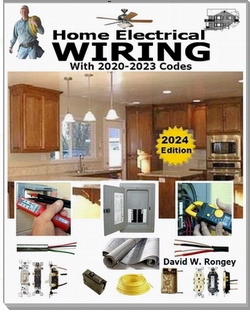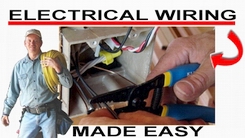» Home Energy Savings
» Need Electrical Help? Ask the Electrician
Stay Cool and Save Energy

|
By Dave Rongey
Summary: If you use air-conditioning, set your thermostat as high as comfortably possible in the summer. The less difference between the indoor and outdoor temperatures, the lower your overall cooling bill will be. © By: Dave Rongey |
Stay Cool This Summer While Saving Energy
Don't set your thermostat at a colder setting than normal when you turn it on. It will not cool your home any faster and could result in excessive cooling and unnecessary expense.
If you're shopping for an air conditioner, look for the Energy Star and Energy Guide labels.
Consider a whole-house fan or evaporative cooler if appropriate for your climate.
Remember that insulation and sealing air leaks will improve energy performance and comfort in summer by keeping cool air inside.
Check out Air Conditioners for more tips.
Air Conditioners
It might surprise you to know that buying a bigger room air-conditioning unit won't necessarily make you feel more comfortable during the hot summer months. In fact, a room air conditioner that's too big for the area it is supposed to cool will perform less efficiently and less effectively than a smaller, properly sized unit. This is because room units work better if they run for relatively long periods of time than if they are continually switching off and on. Longer run times allow air conditioners to maintain a more constant room temperature and remove excess humidity.
Sizing is equally important for central air-conditioning systems, which need to be sized by professionals. If you have a central air system in your home, set the fan to shut off at the same time as the cooling unit (compressor). In other words, don't use the system's central fan to provide circulation, but instead use circulating fans in individual rooms.
Cooling Tips
- Whole-house fans help cool your home by pulling cool air through the house and exhausting warm air through the attic. They are effective when operated at night and when the outside air is cooler than the inside.
- Set your thermostat as high as comfortably possible in the summer. The less difference between the indoor and outdoor temperatures, the lower your overall cooling bill will be.
- Don't set your thermostat at a colder setting than normal when you turn on your air conditioner. It will not cool your home any faster and could result in excessive cooling and, therefore, unnecessary expense.
- Consider using an interior fan in conjunction with your window air conditioner to spread the cooled air more effectively through your home without greatly increasing your power use.
- Don't place lamps or TV sets near your air-conditioning thermostat. The thermostat senses heat from these appliances, which can cause the air conditioner to run longer than necessary.
- Plant trees or shrubs to shade air conditioning units but not to block the airflow. Place your room air conditioner on the north side of the house. A unit operating in the shade uses as much as 10% less electricity than the same one operating in the sun.
- Keep in mind that insulation and sealing air leaks will help your energy performance in the summertime by keeping the cool air inside.
- $ Long-Term Savings Tip: If your air conditioner is old, consider purchasing a new, energy-efficient model. You could save up to 50% on your utility bill for cooling. Look for the ENERGY STAR® and Energy Guide labels. The shopping guide in the back of this booklet will help you find the right size unit for your needs.
- $ Long-Term Savings Tip: Consider installing a whole house fan or evaporative cooler if appropriate for your climate. Check out the Consumer's Guide for more information on efficient cooling.
The Safest Way to Test Electrical Devices and Identify Electric Wires!The Non-Contact Electrical TesterThis is a testing tool that I have had in my personal electrical tool pouch for years, and is the first test tool I grab to help identify electrical wiring. It is a Non-contact tester that I use to easily Detect Voltage in Cables, Cords, Circuit Breakers, Lighting Fixtures, Switches, Outlets and Wires. Simply insert the end of the tester into an outlet, lamp socket, or hold the end of the tester against the wire you wish to test. Very handy and easy to use.
The Quickest Way to Check for Faulty Electrical Wiring!The Plug-In Outlet TesterThis is the first tool I grab to troubleshoot a problem with outlet circuit wiring. This popular tester is also used by most inspectors to test for power and check the polarity of circuit wiring. It detects probable improper wiring conditions in standard 110-125 VAC outlets Provides 6 probable wiring conditions that are quick and easy to read for ultimate efficiency Lights indicate if wiring is correct and indicator light chart is included Tests standard 3-wire outlets UL Listed Light indicates if wiring is incorrect Very handy and easy to use.
Strip Off Wire Insulation without Nicking and Damaging the Electric Wire!The Wire Stripper and Wire CutterMy absolute favorite wire stripping tool that I have had in my personal electrical tool pouch for years, and this is the tool I use to safely strip electrical wires. This handy tool has multiple uses: The wire gauges are shown on the side of the tool so you know which slot to use for stripping insulation. The end of the tool can be used to grip and bend wire which is handy for attaching wire onto the screw terminals of switches and outlets.. The wire stripper will work on both solid and stranded wire. This tool is Very Handy and Easy to Use. |
||
Residential Electrical Parts and AccessoriesLight Switches 120volt Outlets Circuit Breakers Electrician Tools Voltage Testers |














